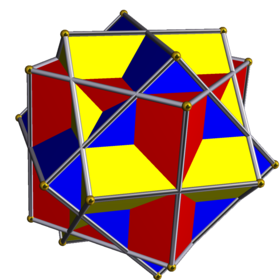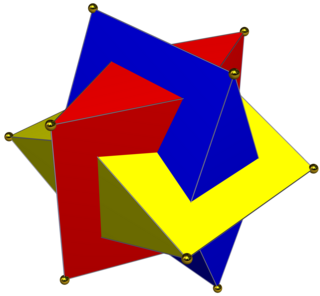Compound of three cubes
| Compound of three cubes | |
|---|---|

| |
| Type | Uniform compound |
| Index | UC8 |
| Convex hull | Nonuniform truncated octahedron |
| Polyhedra | 3 cubes |
| Faces | 6+12 squares |
| Edges | 36 |
| Vertices | 24 |
| Symmetry group | octahedral (Oh) |
| Subgroup restricting to one constituent | 4-fold prismatic (D4h) |
This uniform polyhedron compound is a symmetric arrangement of 3 cubes, considered as square prisms. It can be constructed by superimposing three identical cubes, and then rotating each by 45 degrees about a separate axis (that passes through the centres of two opposite faces).
This compound appears in the lithograph print Waterfall by M.C. Escher. Its dual, the compound of three octahedra, forms the central image in an earlier Escher woodcut, Stars.
In the 15th-century manuscript De quinque corporibus regularibus by Piero della Francesca, della Francesca already includes a drawing of an octahedron circumscribed around a cube, with eight of the cube edges lying in the octahedron's eight faces. Three cubes inscribed in this way within a single octahedron would form the compound of three cubes, but della Francesca does not depict the compound.[1]
Cartesian coordinates
Cartesian coordinates for the vertices of this compound are all the permutations of
- (±√2, 0, ±1)
Related compounds
If the cubes are compressed into rhombic prisms, a compound of 3 rhombic prisms is constructed. The compound has pyritohedral symmetry.[2]
Its vertices are parametrized with lengths a and b with values besides √2.
- (±a, 0, ±1), ( 0, ±b, ±1)
- (±b, ±1, 0), ( 0, ±1, ±a)
- (±1, ±a, 0), (±1, 0, ±b)
References
- ^ Hart, George W. (1998), "Piero della Francesca's Polyhedra", Virtual Polyhedra.
- ^ https://www.software3d.com/Forums/viewtopic.php?t=323
- Skilling, John (1976), "Uniform Compounds of Uniform Polyhedra", Mathematical Proceedings of the Cambridge Philosophical Society, 79: 447–457, doi:10.1017/S0305004100052440, MR 0397554.

